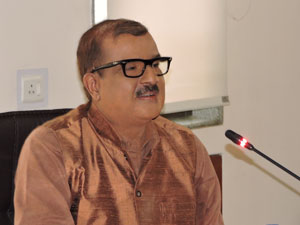The Vivekananda International Foundation (VIF), on 23 Aug 2017, gathered a powerful battery of former top bureaucrats and economic policy experts including Mr. K.M. Chandrasekhar, former Cabinet Secretary, Mr. Rajeev Kher, former Commerce Secretary, Mr. Sashi Sekhar, former Secretary, Water Resources, Dr. Harshvardhan Singh, Executive Directo of Brookings India, Sreekumar Nair, Dr. Sanjay Baru, ex-media Advisor to former Prime Minister Dr. Manmohan Singh, and Mr. TN Ninan, noted economic columnist and author, among many others, for an early assessment of India’s most ambitious tax reform i.e. Goods and Services Tax (GST), a one-point tax substitute for all other indirect taxes, brought in by the present government and effective 01 July 2017.

In his initial remarks, General NC Vij, Director, VIF, observed that successive governments in the past tried to bring in a unified tax code but it is the present NDA-led government which finally crossed the Rubicon. He however stressed that the scale of things, in so far as GST is concerned, is so huge that it will take time for things to settle down to a rhythm. However, the early benefits of the GST are already visible, especially in terms of ease of doing business, cutting down time in transportation of goods, getting more people into the tax-net etc.
In a follow-up presentation, Mr. Chandrasekhar gave a detailed expose of the GST in its present form, besides the road travelled to bring it about. He stressed that the earlier multi-layered tax structure not only proved cumbersome but also had a cascading effect on prices. However, with the GST in place there will be no cascading of taxes on goods and service. The tax element will be reduced considerably by giving credit at each level for tax paid at previous levels. Mr. Chandrasekhar dwelt lengthily on the mechanism of GST, especially the component which deals with credit inputs, revenue sharing between the center and states, the benefits of GST, challenges in implementation of GST etc.

The presentation as also the ensuing interaction among experts seemed to convey that maturation of the GST may take anywhere between 2 to 3 years. Even with GST up and running, there appears to be teething problems and a certain amount of confusion amongst the business community as well as the consumers. These problems relate mostly to legacy issues like complexities arising from bookkeeping, necessity to file too many tax returns, and lack of robust preparedness - skill and infrastructure, lack of clarification on GST provisions (rules and regulations), lack of visibility in passing on credit inputs, problems of coding products into different tax slabs and occurrence of the same product and its variants in more than one tax slab etc. Experts, who gathered for the discussion, broadly agreed that these would get sorted out with due diligence and deliberations over a period of time.
The consensus view that emerged from the deliberations seemed to suggest that the GST will lead to a more efficient tax structure with wider benefits for India’s economy. In his final remarks, the Director underlined the need for education on GST while at the same time he urged for patience.









